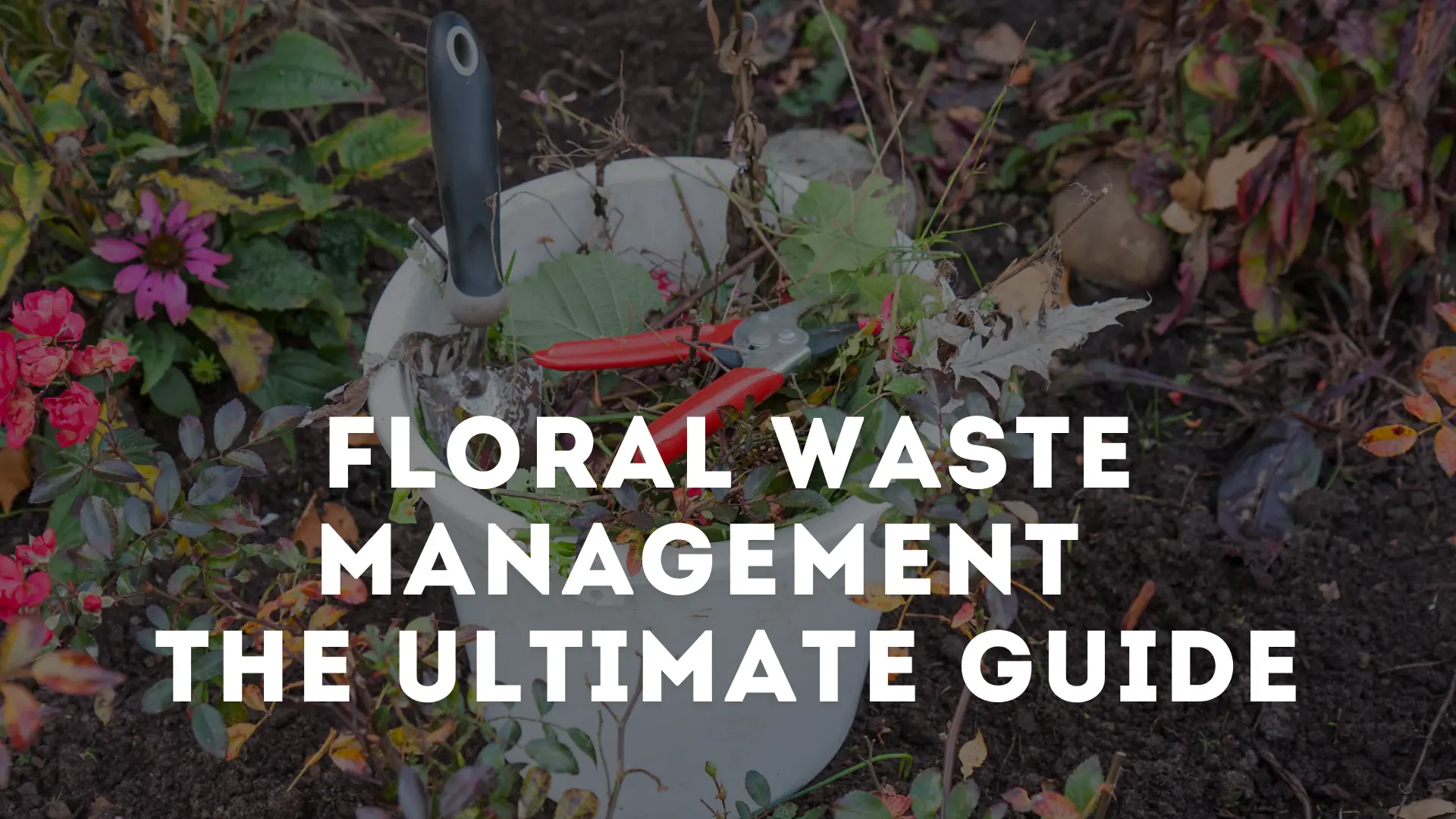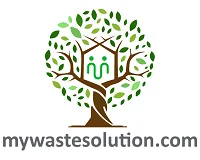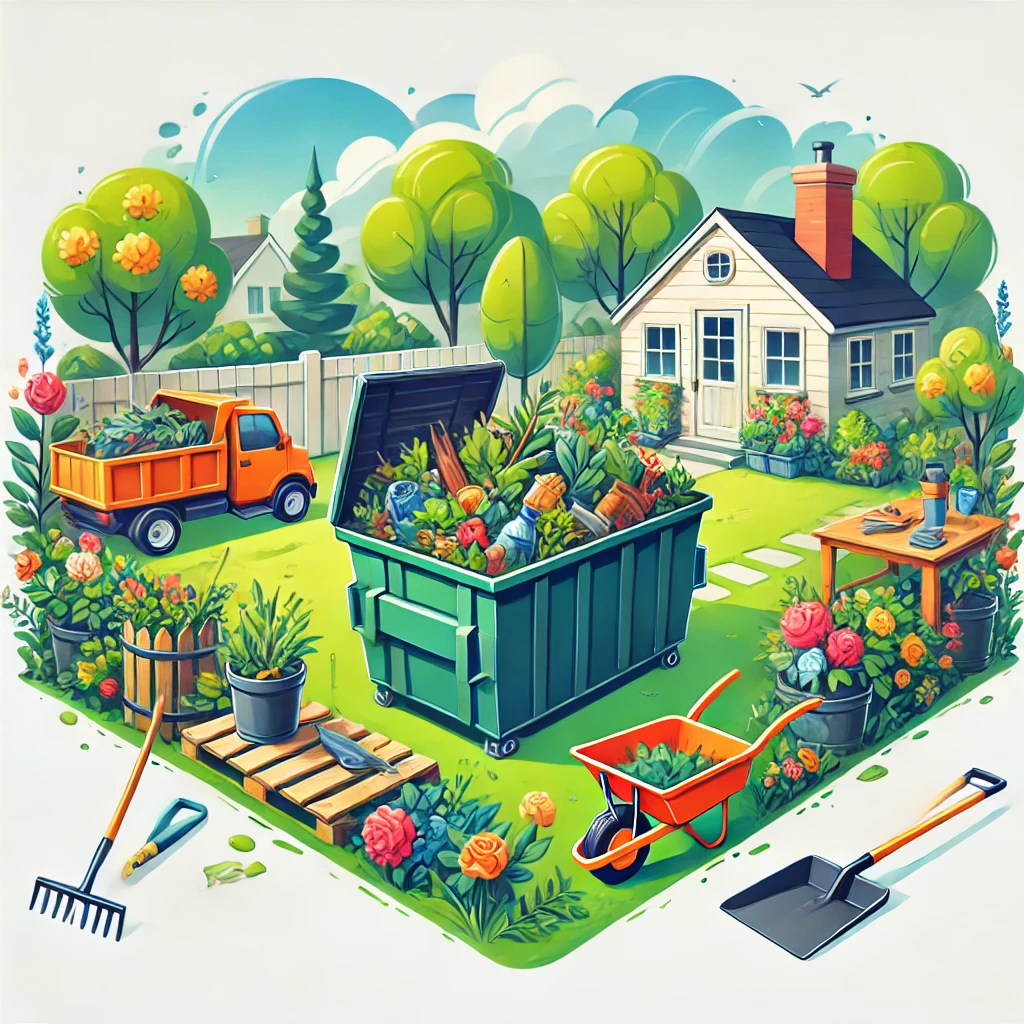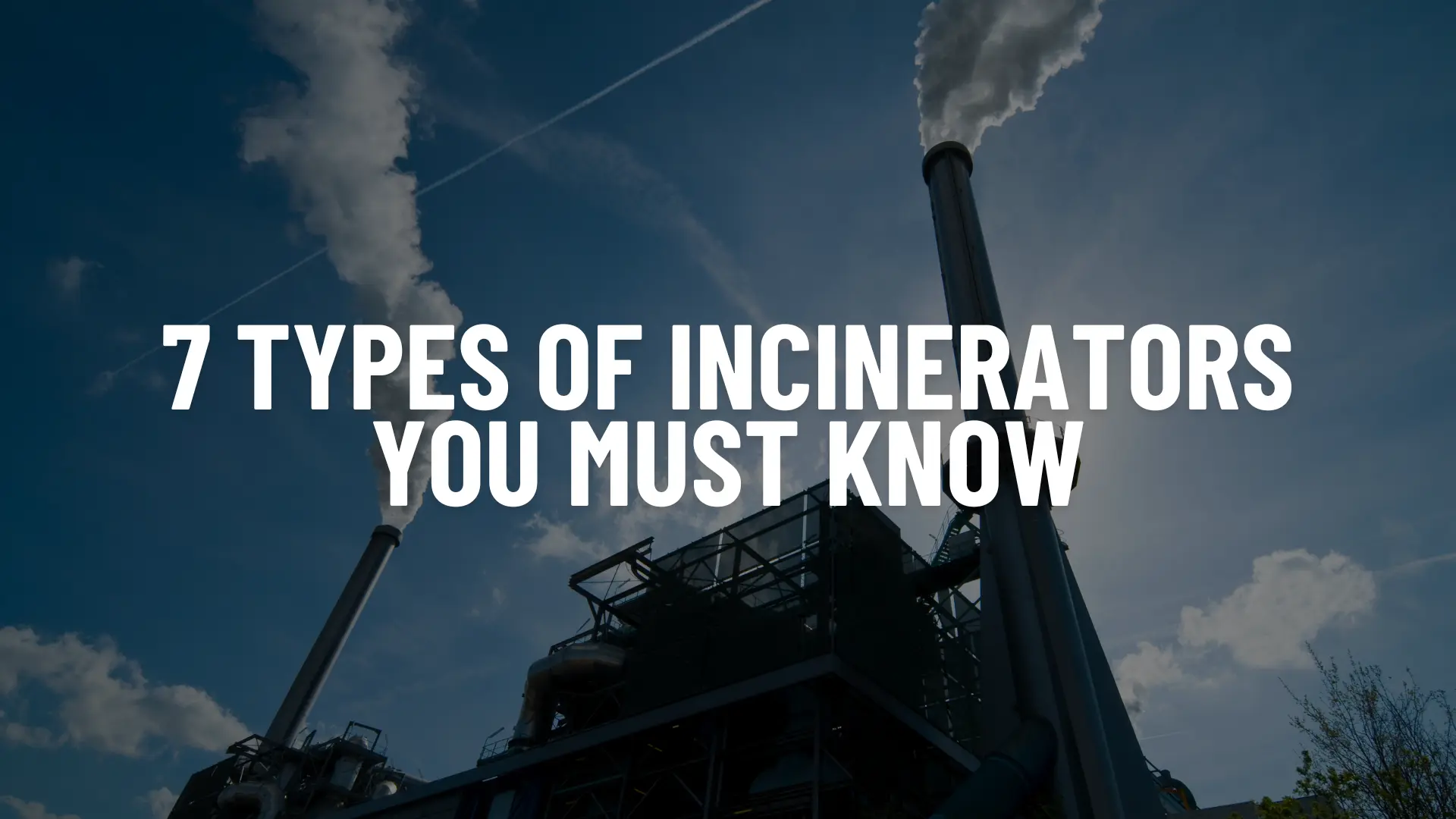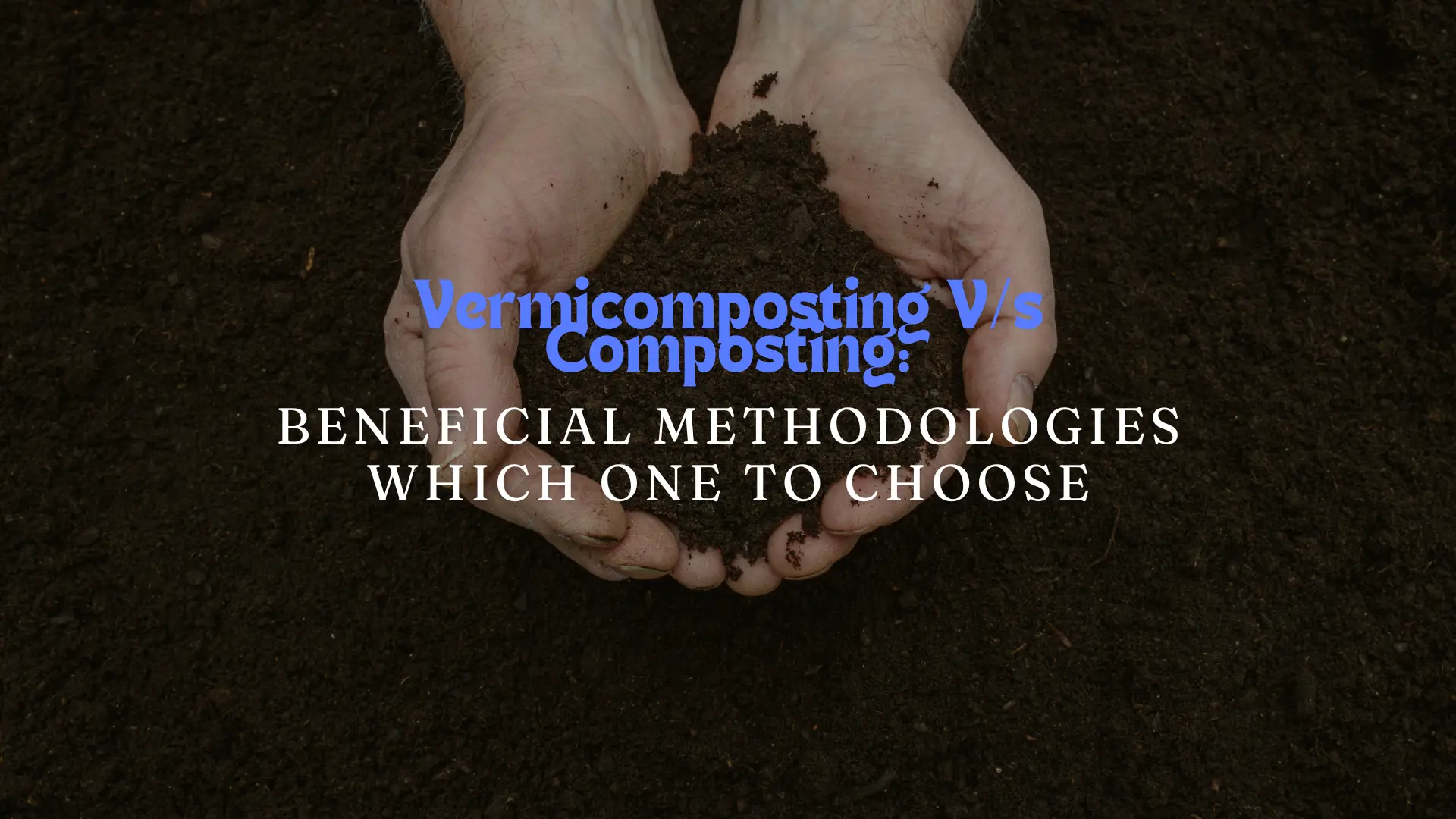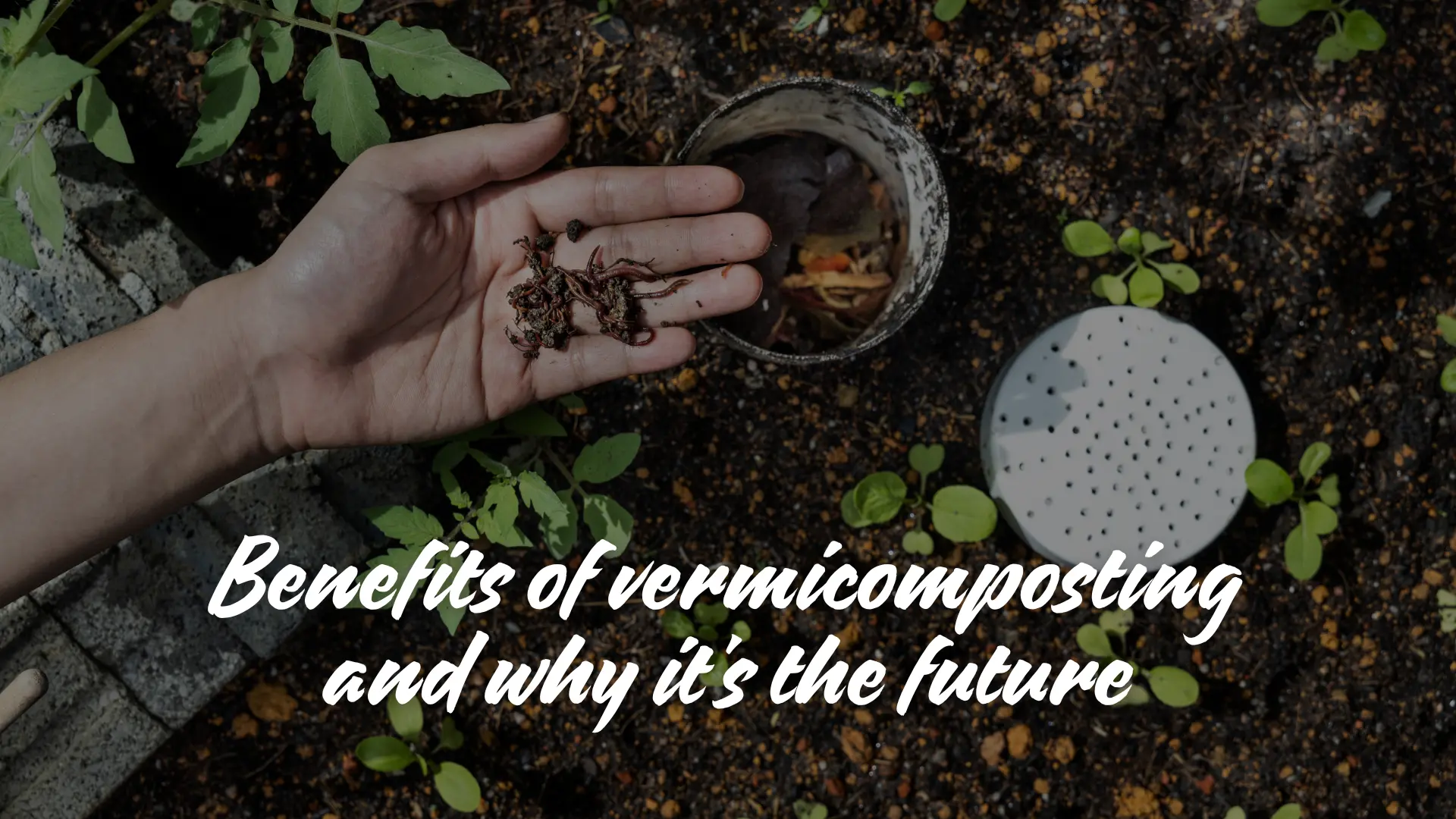1. Introduction
In India, the issue of floral waste management is growing rapidly, making it essential to understand how to handle flower byproducts effectively. Have you ever wondered why we treat flower waste as discarded materials?
Floral waste management specifically addresses the disposal and recycling of floral materials, and improper practices can lead to serious environmental and health challenges. Unfortunately, in many areas, flower waste disposal is often handled carelessly. However, recycling these floral byproducts into value-added solutions presents a promising opportunity. Not only does effective floral waste management contribute to sustainability, but it also opens the door to a variety of eco-friendly alternatives!
In this blog, we’ll explore effective strategies for managing flower byproducts and the technologies available for their commercial use. Get ready to discover how we can transform refuse into opportunity!
2. Impact of Floral Waste on the Environment
“Colorful flowers, often offered to deities, end up as floral waste in rivers.”
As discussed, floral byproduct management focuses on the environmental impact of these discarded plants. When flower waste is thrown into water sources, it disrupts ecosystems, highlighting the urgent need for proper waste handlingand floral waste disposal.
Additionally, toxic chemicals from pesticides and insecticides used in flower cultivation leach into rivers, making them hazardous. Substances like arsenic, lead, and cadmium can contaminate aquatic environments, causing dangerous pH fluctuations (6 to 8.5), further exacerbating the environmental impact of improper floral waste disposal.
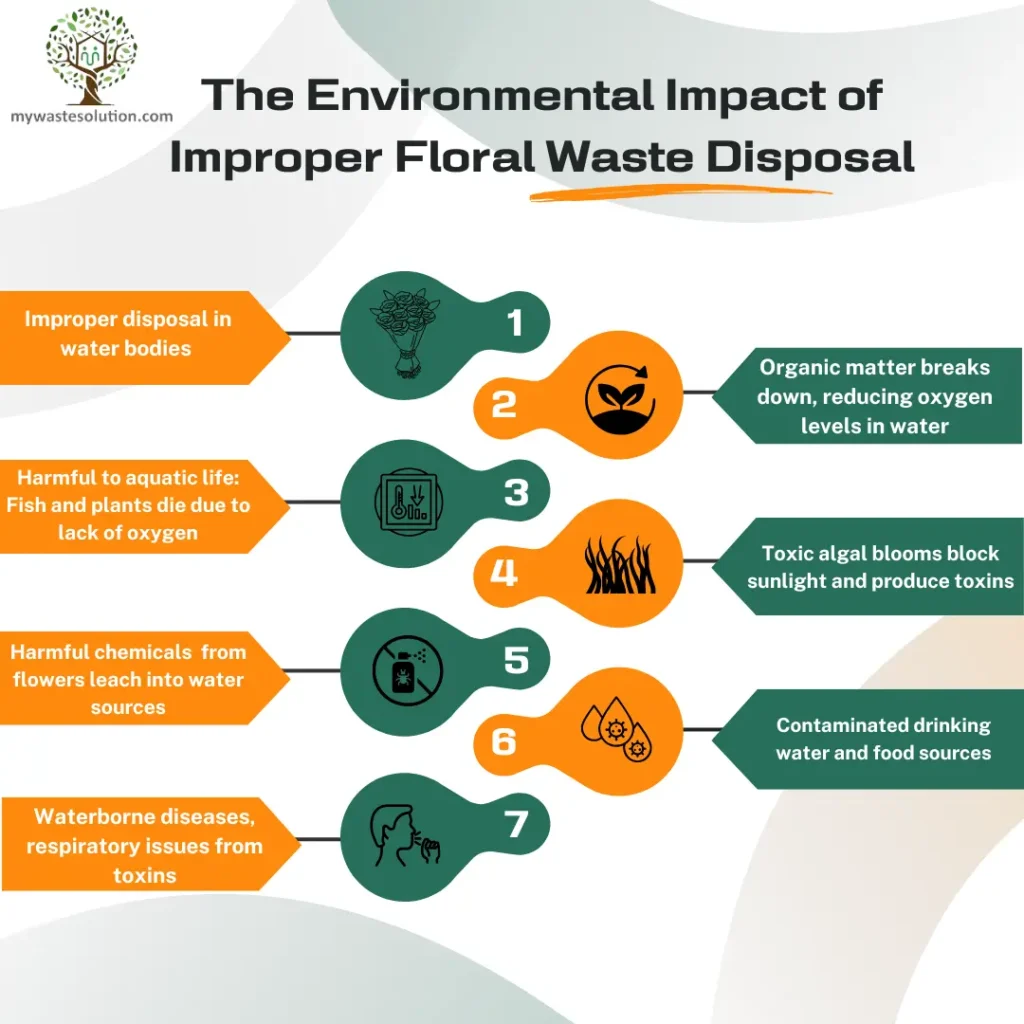
Surprisingly, floral refuse accounts for 16% of total river pollutants. As decaying flowers degrade water quality, pesticides seep into these bodies, harming marine life and contributing to health issues like cholera and severe diarrhea—leading causes of child mortality worldwide. Additionally, this waste disrupts aquatic life and undermines the stability of our vital water sources.
Explore Organic Waste Management and Recycling Solutions
Find top machinery, plants, tools, resources, companies, and consultancy for comprehensive floral and flower waste management needs.
Through effective floral waste management, we can significantly mitigate these environmental impacts and work towards a healthier, more sustainable ecosystem. Let’s explore how floral byproduct management can make a real difference in preserving our environment!
See also:About 2 million tonnes of flower waste in India are discarded every day after religious ceremonies.
3. Floral Waste in India
India produces large amounts of flower byproducts, creating a significant opportunity for growth in floral waste management. These blooms are commonly used in religious settings and as raw materials in various industries. However, the issue of floral waste disposal is often inadequately addressed. Daily, flowers offered by devotees in temples are discarded as floral refuse, accumulating from practices in temples, mosques, and gurudwaras.
In addition to religious sites, significant amounts of floral waste are generated in residential areas and community centers. The safe disposal of this flower waste is a pressing concern, as it is often carelessly discarded into rivers and oceans, severely impacting the environment. Furthermore, waste from flowers is produced at hotels, wedding venues, and during sacred ceremonies, underscoring the urgent need for effective floral waste management in these areas.
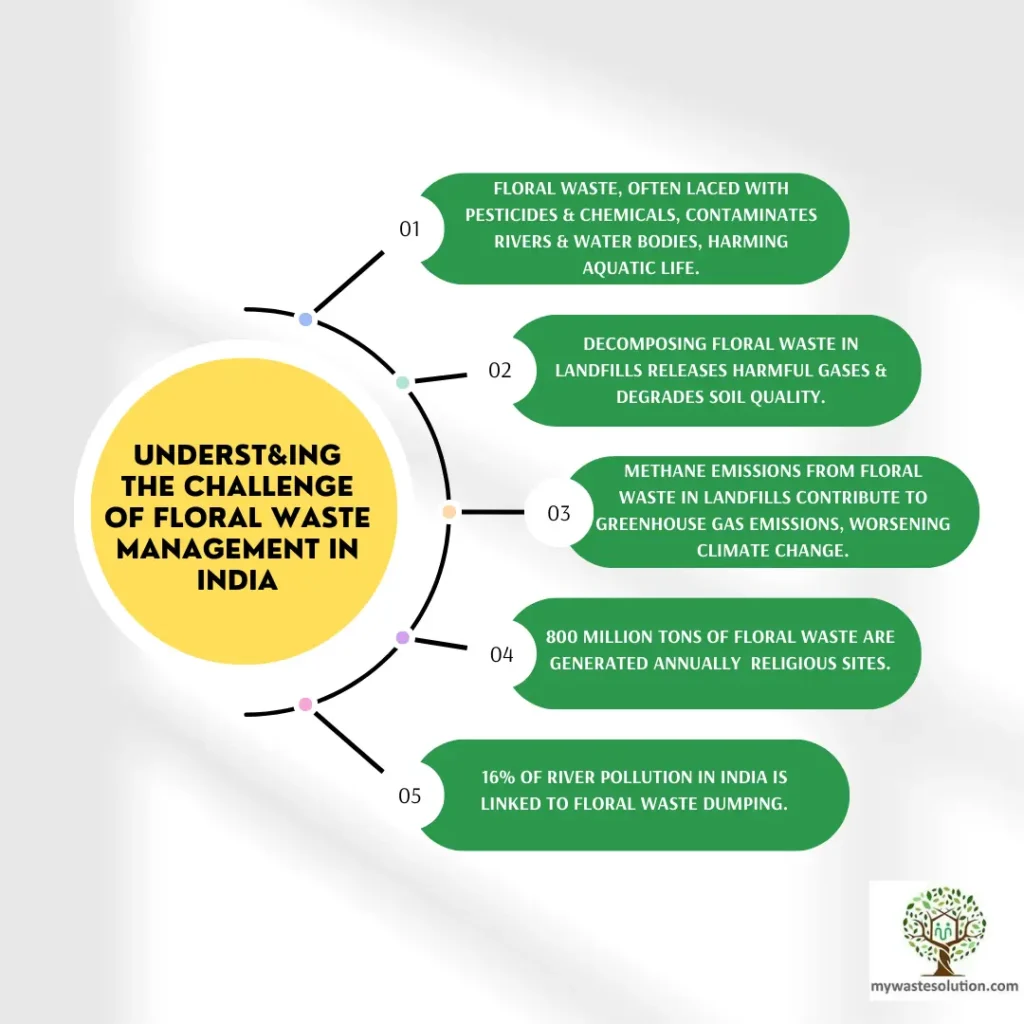
India’s flower production was estimated at nearly 3 million metric tons in 2021. While the pandemic caused a slight decline, blooms like marigolds, lotuses, roses, and sunflowers still dominate the market. Alarmingly, the same volume of floral waste is discarded, equaling the amount produced, underscoring the urgent need for robust floral waste management strategies.
By addressing these challenges, we can transform floral refuse into valuable resources and contribute to a more sustainable floral waste management future!
Struggling with floral and flower waste management needs? Connect with top consultants specializing in floral and flower waste management solutions.
Connect NowSee also: Production volume of flowers in India.
After a single use, fresh blooms are often discarded in bins or end up in rivers. But what comes next? The answer is simple: floral waste management. On one side, we have floral refuse, and on the other, booming technology that can transform this floral byproduct into valuable resources. By harnessing these innovations, we can unlock green business opportunities.
Effective floral waste management addresses disposal issues while paving the way for a thriving bioeconomy. Converting flower waste into useful products helps reduce pollution and creates eco-friendly business models.
Let’s explore how effective floral waste strategies can lead to a greener, more sustainable future!
4. 11 Sustainable Floral Waste Solutions
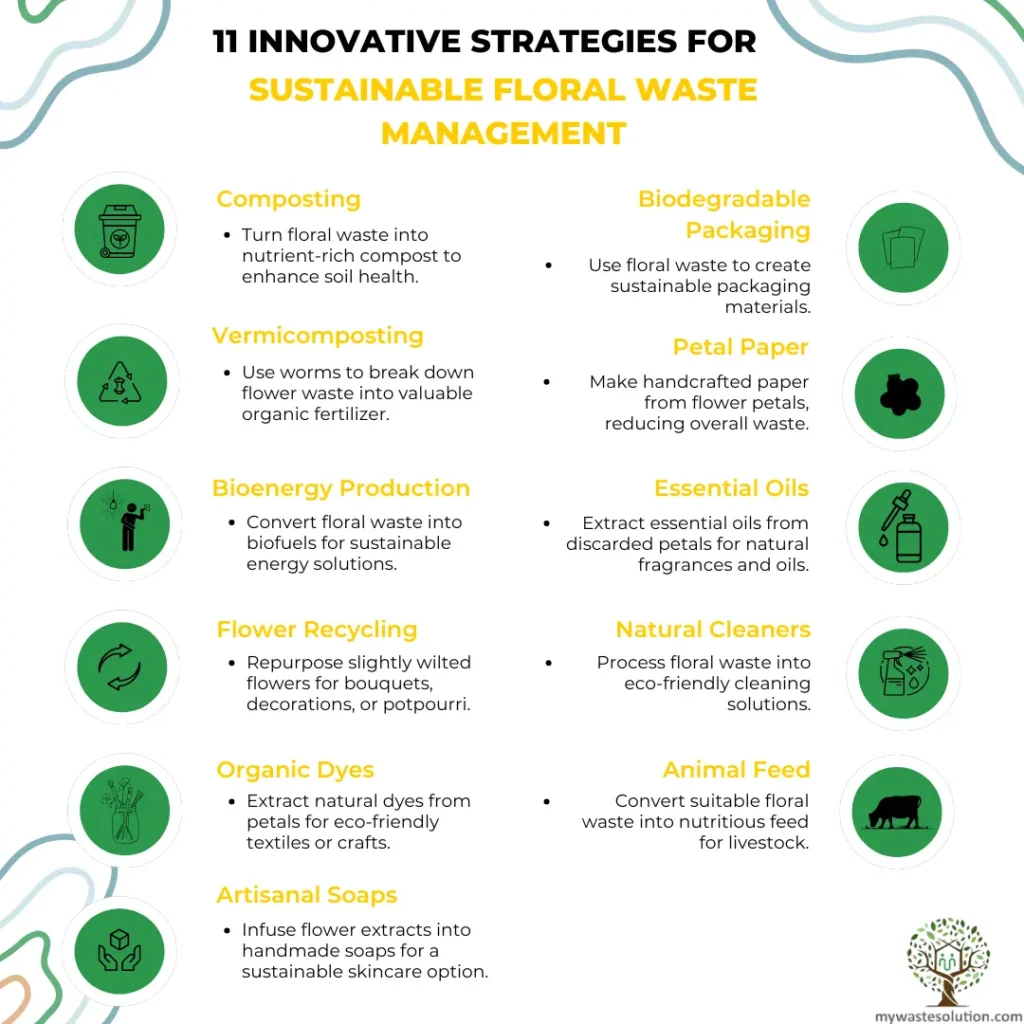
1. Composting Floral Waste
An effective approach to handling floral waste is by creating compost from used blooms. These flowers can be transformed into nutrient-rich vermicompost through bioconversion, addressing solid floral refuse management with petals as a primary organic source.
Find and connect with leading companies specializing in floral and flower waste management solutions.
Get Connected Today
To successfully compost floral waste, it’s essential to separate blooms from other refuse. Installing dedicated bins for organic remnants can simplify this task. Begin by detaching the petals and adding them to a compost heap, enclosed bin, or ground pit. Incorporate stems and leaves to provide nitrogen, mixing the green parts with cow dung.
Introducing earthworms, particularly Eisenia fetida, enhances the vermicomposting process, making it more efficient for managing organic floral refuse from temple offerings.
The primary benefit of vermicomposting is its eco-friendly nature; it not only tackles the challenge of organic disposal but also helps reduce odor issues. Additionally, by utilizing composting machines, we can further streamline this method and contribute to a more sustainable approach to floral waste utilization.
Let’s discover more eco-friendly techniques to maximize our floral remnants!
See also:Want to know more about the benefits of vermicomposting?
Figure: Vermicompost from floral waste.
2. Biogas and Bioethanol Production
Abundant blooms across India are ideal feedstock for biogas generation. They provide substantial yields at a rapid rate, offering a significant advantage in waste management. Amid the ongoing energy crisis, bioethanol has become a promising alternative to fossil fuels. Microorganisms ferment sugars from various sources, including these blooms, into ethyl alcohol, emphasizing their role as essential raw materials in bioethanol synthesis.
In regions like Maharashtra, Andhra Pradesh, and Chhattisgarh, tribal communities harvest mahua blossoms for traditional alcoholic beverages, utilizing them not only for alcohol but also for vinegar. Moreover, employing mahua as a substrate for ethanol production via submerged fermentation offers notable economic benefits, promoting sustainable practices and supporting local economies.

Explore the best organic waste treatment and recycling machinery and equipments for your industrial needs.
Connect TodayBy tapping into the potential of floral waste for biogas and ethanol generation, we can contribute to a greener, more sustainable energy future!
3. Organic Acids – Oxalic Acid
In India, sugarcane is the primary raw material for oxalic acid, but mahua flowers offer a promising alternative source for flower waste management and oxalic acid production due to their higher sugar content. Oxalic acid is widely used as a chelating agent and preservative in various industries.
Other applications of oxalic acid include cleaning and bleaching, particularly for rust removal. It acts as a rust remover by forming a stable water-soluble salt with ferric iron, known as the ferrioxalate ion. Cleaning products often contain oxalic acid, and it also appears in some tooth whitening products. Around 25% of produced oxalic acid is used in dyeing processes as a mordant. Additionally, it plays a key role in the pulpwood industry for bleaching and contributes to the production of baking powder.
By exploring the potential of mahua flowers in floral waste management and oxalic acid production, we can enhance the sustainability of our chemical industries, effectively manage flower waste, and create valuable resources from floral byproducts!
See also: Learn more about oxalic acid.
4. Dyes
Marigold and rose flowers from temples serve as excellent sources for preparing biodegradable dyes. These eco-friendly colorants offer a sustainable alternative to synthetic options across various applications. A notable example is extracting dye from saffron flower petals for Pashmina shawls, showcasing a viable replacement for synthetic colorants.
The main advantage of these natural dyes is their eco-friendly nature, causing no allergic reactions on the skin. Additionally, these flowers are widely cultivated, readily available, and inexpensive, making them ideal for dyeing paper in both small and medium enterprises, as well as larger commercial operations.
Dye extracted from marigold (Tagetes erecta L.) waste finds use in the textile industry and in antioxidant treatments. By leveraging the potential of floral waste for dye production, we can contribute to sustainable practices in the floral waste management and dyeing sectors!
Fig: Dye from floral waste
5. Pigments
Pigments serve as stains and additives in beverages, cosmetics, printing, dyeing, and as natural food colorants. One notable pigment, carthamidin, finds use in ice creams and various other food products, presenting a fantastic opportunity to repurpose large quantities of floral waste.
Safflower pigments, such as red (carthamin) and yellow (carthamidin), commonly contribute to dyeing and textile coloration. Safflower petals contain approximately 30% yellow and 0.83% red pigment. Additionally, marigold flowers, ranging from yellow to orange-red, provide a rich source of lutein and carotenoid pigments. Lutein is gaining popularity as an active ingredient in the food industry and for textile coloration.
Moreover, the natural pigmentation of poultry, particularly broilers, depends on the carotenoid content in their diet. Producers use extracts from marigold flowers as an additive in poultry feed to enhance egg yolk pigmentation.
By leveraging the potential of floral waste for pigment production, we can support sustainable practices across multiple industries and promote floral waste management!
Figure: Food products from floral waste.
6. Biosurfactant Production
Biosurfactants exhibit strong antibacterial, antifungal, and antiviral activity. They also act as anti-adhesive agents to pathogens, making them valuable for treating various diseases and serving as therapeutic and probiotic agents.
Researchers can produce biosurfactant compounds using Microbispora sp. V2 with flower extracts from Madhuca latifolia L. Studies show that surface-active compounds possess significant biosurfactant properties. For instance, the cell-free supernatants of Madhuca latifolia flower extract medium with 20 µg/ml of anthracene can reduce surface tension to 35%. The glycoprotein biosurfactant displays excellent wetting ability and demonstrates robust antibacterial, antifungal, and antiviral activity.
Madhuca latifolia L. flowers represent a promising bioresource for producing exopolysaccharides with surface-active properties. By leveraging floral waste for biosurfactant production, we can enhance sustainability and explore innovative solutions in healthcare and environmental applications!
7. Incense Sticks from Floral Wastes
Methods have been developed to create herbal incense using floral and flower waste. You might be surprised at how simple the process is! Let me quickly guide you through it.
First, workers hand-segregate flowers from flower waste and spray an organic bioculum on them to eliminate any chemical residues. Next, they powder dried petals and mix them with natural plant resins and clay to form a dough-like mixture. This mixture is hand-rolled into raw incense products, which are then dried. Finally, the dried sticks are dipped in essential oils to impart a pleasant fragrance.
Flowchart:
- Segregate flowers from waste
- Remove petals and sun-dry them
- Dried petals are crushed to powder
- Powder is mixed with clay to make the dough
- Dough is shaped into incense
- Incense is dried and dipped into essential oils
- Incense is ready!
By transforming floral waste into beautiful and fragrant incense, we can contribute to sustainable practices and promote eco-friendly products!
Sustainable Business-from flower waste to incense.
8. Floral Waste in Biosorption Applications
Biosorption refers to the ability of organic materials to absorb heavy metals from waste, particularly from water. These metals commonly come from industries such as electroplating, paint and pigments, steel production, and electrical batteries.
Unfortunately, these metals cannot be biologically degraded into harmless products and often end up in aquatic environments. Biosorption offers an attractive technology for removing heavy metal ions, utilizing low-cost biosorbents.
Floral waste can serve as one of the best biosorbents, providing an eco-friendly solution to heavy metal pollution. By leveraging the natural properties of floral waste and flower waste, we can effectively contribute to cleaner water and a healthier environment, supporting floral waste management practices!
| Name of flowers | Application |
| Carnation, rose and daisy | Biosorption of acid blue 9 |
| Red rose-Biomass derived after colourextraction of flower | Biosorption of Pb(II) and Co(II),Removal of chromium(VI) from aqueous phase |
| Medlar male flower | Biosorption of nickel |
| Palm flower | Biosorption of Cr(VI) and Cr(III) |
Table: Application of floral waste in biosorption studies
9. Fragrance from Waste Flowers
Isn’t the thought exciting? Every flower has a distinct smell from unique chemicals that facilitate pollination and create delightful fragrances. We can process floral waste to manufacture fragrant perfumes and soaps.
In many parts of India, farmers cultivate rose flowers year-round, presenting a great opportunity for commercial production of floral extracts. Approximately 80% of rose flowers go into rose water, 10% into attar, and 1-2% into pankhuri. Manufacturers use rose oil as a fragrance in pharmaceutical preparations, with extensive use in ointments and lotions.
These organic products derive from just one flower—the rose—but similar processes apply to other flowers, too! By harnessing the potential of floral waste, we can create a range of fragrant products while actively promoting sustainability and floral waste management!
10. Floral Waste for Handmade Paper Production
Imagine paper made from flowers! Floral waste management serves as an eco-friendly source for handmade paper production. This method effectively recycles and reuses floral waste, resulting in environmentally friendly paper.
Handmade paper from flower waste offers numerous advantages. It contains no wood or toxic chemicals, making it a sustainable choice. By using floral waste, we significantly reduce, reuse, and recycle, which are crucial principles in sustainable practices.
Additionally, this innovative approach addresses the disposal problem of floral waste, transforming a potential environmental issue into a valuable resource. Embracing floral waste for handmade paper production provides a fantastic opportunity to contribute to a greener planet!
11. Biodegradable Thermocol from Flower Waste
Florafoam provides a 100% biodegradable and sustainable alternative to harmful thermocol.
You might be shocked to learn that 91% of traditional thermocol gets used only once. Manufacturers produce it from toxic chemicals like benzene and styrene, both known carcinogens linked to leukemia and lymphoma. Unfortunately, no technology currently exists to recycle thermocol; instead, people compress it and dump it in soil, or its production remains energy-intensive, leading to harmful greenhouse gas emissions.
By replacing thermocol with biodegradable alternatives like Florafoam derived from floral waste, we can promote eco-friendly solutions and address the challenges of floral waste management while reducing the environmental impact of toxic materials.
Struggling with floral and flower waste buying and selling issues? Connect with organic waste buyers and sellers here.
Buyer Listings Seller ListingsIn contrast, Florafoam provides a high-performing, moldable, and durable material. You can easily bury it in your garden for decomposition. This innovative material shapes to any size and strength, depending on usability, and offers superior functionality compared to traditional thermocol. Additionally, it is fire-resistant!
Ultimately, Florafoam serves as an eco-friendly and cost-effective alternative to thermocol while effectively utilizing floral waste. By embracing this solution, you not only help combat environmental issues but also promote sustainabilityand floral waste management!
See also: Other Applications of flowers.
5. Indian Startups Recycling Floral Waste into Eco-Friendly Products
Let’s celebrate some successful journeys of Indian startups making a difference!
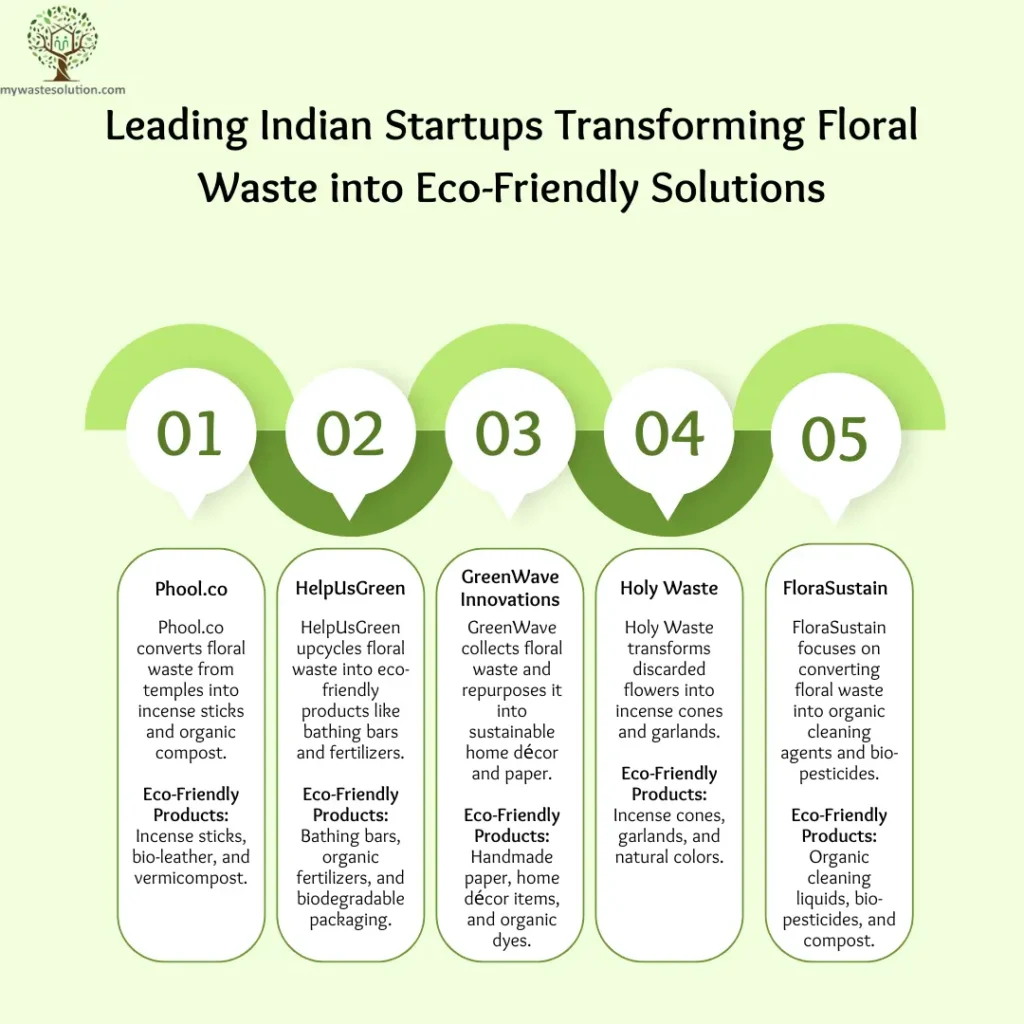
Phool
Phool is an innovative Indian startup tackling the significant issue of temple waste. They collect 8.4 tons of floral wastefrom temples in Uttar Pradesh daily. This material transforms into charcoal-free incense, promoting sustainability and minimizing environmental impact.
Phool uses organic and eco-friendly packaging for all their products, ensuring they remain sustainable. Notably, all items are handcrafted by women, providing them with a source of income and healthy livelihoods.
Furthermore, these artisans actively engage in the recycling process, creating Florafoam, a biodegradable alternative to traditional thermocol.
In this context, Phool exemplifies how startups can effectively convert floral waste into valuable products while simultaneously empowering communities and fostering sustainability and floral waste management!
Visit website:Phool
Holy Waste
This startup aims to make waste beautiful! HolyWaste converts floral waste into organic, child-safe lifestyle products for daily use. In addition to promoting sustainability, the company creates employment for women in target markets.
In Hyderabad, an estimated 7,000 metric tons of garbage are generated daily, with around 1,000 metric tons of flowers entering the market each day. Unfortunately, this results in a similar amount of floral waste being discarded the next day after use. HolyWaste segregates flower waste from other refuse and processes it into eco-friendly products, such as natural fertilizers, incense, and soaps.
The company actively explores various product possibilities with floral waste, and their commitment to sustainabilitypositions them for continued growth in the eco-friendly market!
Visit website:Holy Waste
HelpUsGreen
HelpUsGreen is a social enterprise based in Kanpur, India, founded in 2015. The organization aims to preserve the Ganges by recycling waste from places of worship. They transform floral byproducts into organic items with the assistance of rural women.
Every day, HelpUsGreen collects 2.4 tons of flower byproducts from temples and mosques in Uttar Pradesh.
They repurpose this material into charcoal-free and “bamboo-less” incense, helping to manage floral refuse while contributing to the revival of the Ganges River.
Additionally, HelpUsGreen actively develops methods to convert discarded flowers into bio-ethanol, further enhancing their commitment to sustainability and innovation in floral waste management. Notably, their efforts promote eco-friendly practices and empower local communities!
Visit website: HelpUsGreen
6. Future of Floral Waste in India
India, known as the land of flowers, offers vast opportunities for floral waste management. Implementing flower recycling technology reduces waste and enhances the circular economy. By effectively managing floral waste, we minimize organic waste in aquatic systems, benefiting underwater life and reducing water pollution. This effort creates a cleaner environment for future generations and establishes a steady supply chain for raw materials. With immense potential, India stands ready for innovative floral waste management solutions and successful startup stories.
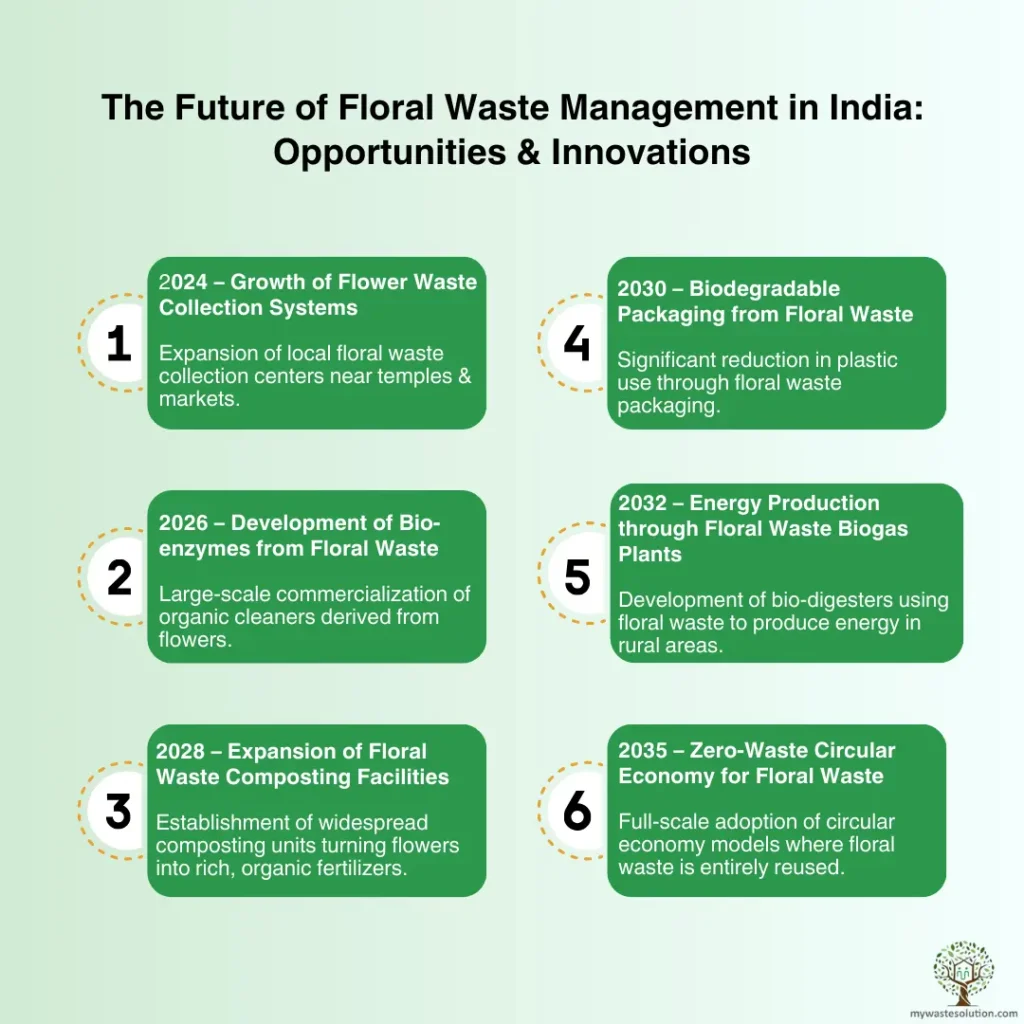
7. Conclusion
Value-added products from floral waste offer numerous benefits: compost enhances plant growth, biogas generates electricity, and food items provide nutrients and additives. Dyes and pigments derived from flower remnants find significant applications in various textile and paper industries.
Moreover, producers create biofuels and bioethanol from plant material, significantly addressing the energy crisis. Additionally, floral remnants contribute to biosorption, aiding in wastewater treatment and ultimately reducing water pollution and environmental pollution.
Furthermore, effective bioremediation of floral waste plays a vital role in solid waste management and positively contributes to the bioeconomy. Thus, with strategic floral waste management, we can convert waste into wealth, showcasing the immense potential of floral materials as valuable resources.
